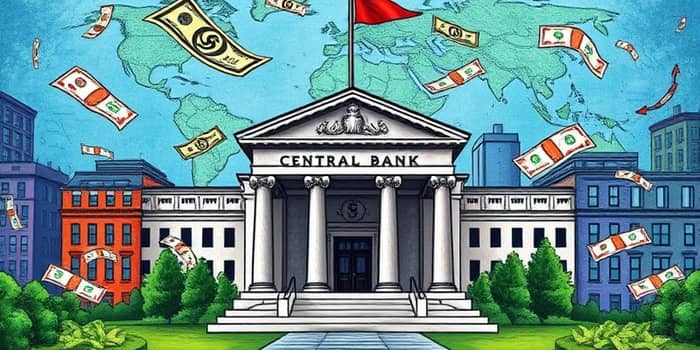
Monetary policy is a powerful tool that central banks wield to steer economic outcomes in times of crisis and recovery. In an era defined by global financial upheavals, innovations in central bank interventions—namely Quantitative Easing (QE) and Quantitative Tightening (QT)—play a pivotal role in shaping credit conditions, asset prices, and inflation dynamics. This article offers a comprehensive examination of these contrasting approaches, illuminating their mechanisms, effects, and the debates they ignite among economists, policymakers, and investors alike.
At its heart, QE and QT represent opposing strategies for managing a central bank’s balance sheet and influencing liquidity across the financial system. Understanding these tools is essential for grasping how policy shifts ripple through markets and real activity.
The concept of QE first emerged in Japan during the early 2000s in response to prolonged deflationary pressures. Its adoption by the U.S. Federal Reserve in 2008 marked a watershed moment, as traditional policy rates had already approached zero. Central banks such as the European Central Bank and the Bank of England followed suit, adapting the tool to their specific economic contexts.
QT, by contrast, reflects a relatively newer practice of balance sheet normalization aiming to restore monetary policy to a neutral stance. While less tested than QE, recent episodes demonstrate its potency in signaling central bank resolve to curb inflation and realign expectations.
In practice, QE often involves large-scale asset purchases including mortgages, while QT operates through passive roll-off or direct sales to remove excess reserves from the banking system. These operations underscore a shift from crisis management to stabilization, with profound implications for borrowers and investors.
The modern application of QE began in the aftermath of the 2008 global financial crisis, with central banks across advanced economies deploying unprecedented support measures. Over time, these efforts evolved into varied rounds of expansion and subsequent normalization.
This chronology underscores central banks’ shift from aggressive easing during crises to cautious tightening once recovery gains momentum. Each phase reflects a learning curve, as institutions calibrated the size, pace, and communication of their interventions to balance effectiveness against unintended consequences.
QE and QT influence the economy through multiple interconnected pathways. These channels determine how quickly and intensely policy changes affect spending, investment, and prices.
1. Interest Rate and Yield Effects: QE compresses long-term bond yields, lowering borrowing costs for businesses and households. QT reverses this by reducing demand for bonds, causing yields to rise and borrowing rates to increase across credit markets.
2. Signaling and Expectations: Beyond actual asset purchases, QE signals a commitment to low rates for an extended period, shaping market and consumer expectations. QT announcements, similarly, indicate tightening ahead, influencing wage negotiations, investment decisions, and inflation outlooks.
3. Portfolio Rebalancing: Investors seek higher yields by shifting from government debt to corporate bonds, equities, and real estate during QE. QT can trigger a reversal as safe assets become comparatively more attractive, potentially leading to volatility across asset classes.
4. Currency and Capital Flow Channel: By altering relative interest rates, QE can weaken a currency, boosting exports but raising import costs. QT often strengthens the currency, impacting trade balances and capital movements, particularly in emerging markets.
These channels do not operate in isolation; they interact with fiscal policies, regulatory changes, and global economic conditions to shape outcomes. For instance, stimulus spending can amplify QE’s effects, while regulatory tightening can blunt QT’s impact on bank lending.
The deployment of QE and QT has far-reaching consequences, affecting various sectors and stakeholders. Understanding these effects helps in forecasting potential trade-offs and tailoring policies to current challenges.
Interest Rate Dynamics: Empirical research shows QE flattening the yield curve can reduce government bond yields by as much as 0.5 percentage points. QT reverses these gains more quickly, often leading to sharper increases in long-term rates.
Banking Sector Effects: QE expands bank reserves but can compress net interest margins, affecting profitability and lending incentives. Under QT, banks may face funding pressures if market liquidity conditions deteriorate sharply, prompting more conservative credit standards.
Government Budgets: QE lowers debt-servicing costs and, by stimulating growth, generates additional tax revenue, helping to improve fiscal positions. Conversely, QT raises interest expenses on sovereign debt and may slow revenue growth if economic activity softens.
Global Spillovers and Emerging Markets: U.S. QE episodes have historically triggered capital inflows into emerging economies, peaking at $3.9 billion and boosting local stock prices by up to 3% over several months. In contrast, QT phases can lead to currency depreciation and higher bond yields, increasing external financing costs for these markets.
Additionally, nonbank financial institutions—such as hedge funds and pension funds—have increasingly absorbed bonds sold during QT, influencing market liquidity and price discovery. Their growing role has added complexity to the transmission of monetary policy shifts.
While QE has been credited with averting deeper recessions and deflationary spirals, it also carries side effects. Critics argue prolonged easing can inflate asset bubbles and deepen inequality, as the beneficiaries of rising asset prices disproportionately include wealthier households.
Transitioning to QT poses unique challenges. Rapid balance sheet reductions risk sudden spikes in yields and liquidity shortages, potentially destabilizing markets. Central banks must carefully time announcements and calibrate the pace of withdrawals to avoid preventing sudden financial market disruption while still combating inflation.
Moreover, the optimal mix of QE, QT, and conventional rate adjustments remains a topic of debate. Coordinated strategies with fiscal authorities can enhance effectiveness, but misalignment can create policy conflicts and muddy accountability. Effective communication is therefore paramount to set clear expectations and avoid surprises.
Long-term structural effects are also under scrutiny. Extended periods of QE can alter risk appetites, corporate financing choices, and household saving behavior, potentially necessitating regulatory reforms to safeguard financial stability once normalization begins.
Quantitative Easing and Tightening represent two sides of the monetary policy spectrum, each deployed to address distinct economic challenges. QE emerged as a crisis response tool to flood markets with liquidity, while QT offers a pathway back to policy normalization and inflation control.
Historical experiences illustrate the nuanced trade-offs central banks face: stimulating growth without igniting bubbles, and tightening without triggering market disruptions. The evolving narrative of QE and QT underscores the importance of transparency, data-driven decision-making, and international coordination.
As central banks navigate a complex post-pandemic landscape characterized by supply shocks, elevated debt levels, and shifting geopolitical dynamics, a deep understanding of QE and QT is indispensable. By learning from past episodes and adapting to emerging conditions, policymakers can strike the delicate balance between fostering sustainable growth and preserving price stability in a globally interconnected economy.
References













